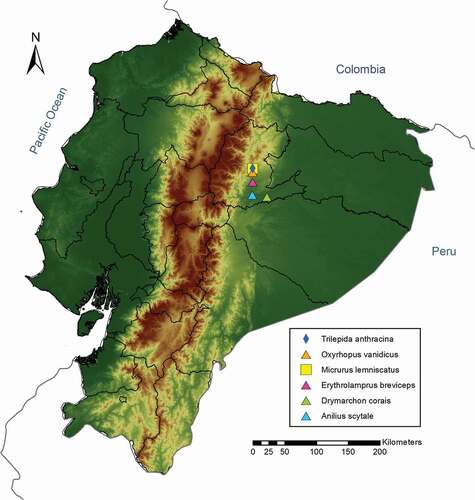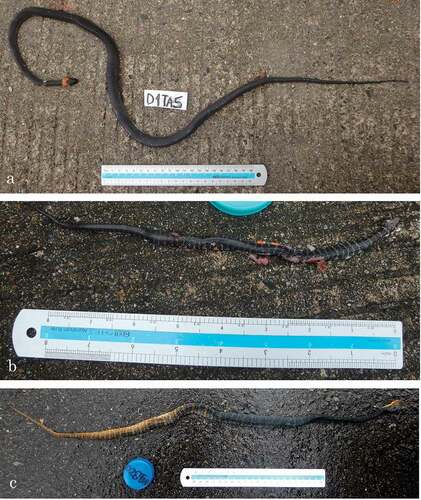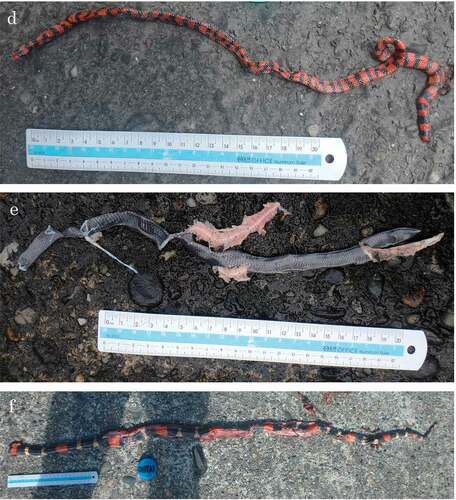ABSTRACT
Monitoring wildlife roadkills is a valuable method to identify critical areas where animals are more susceptible to collision with vehicles, likewise, this type of work can let us know which species are more vulnerable to this human impact. Besides these relevant utilities used for mitigation purposes, this effort can provide very important information about the biology, ecology and biogeography of species. In this paper, we report new geographic records found while working on a road ecology study. These data increase the distribution of six snakes’ species (Anilius scytale, Drymarchon corais, Erythrolamprus breviceps, Micrurus lemniscatus, Oxyrhopus vanidicus and Trilepida anthracina), from which, four show scarce and almost inexistent historical records (Anilius scytale, Drymarchon corais, Erythrolamprus breviceps, and Trilepida anthracina). We encourage researchers, especially road ecologists, to notice and report these observations, which can be highly valuable for expanding the knowledge of species distributions, a key factor forconducting integral studies of fauna.
Transportation networks constitute a great source of mortality for many groups of fauna. Among these largely affected groups, snakes have shown the highest numbers across several studies [Citation1–3], which is basically given by their slow locomotion and their attraction to warm roads for thermoregulation [Citation2].
Although roads can be a huge threat to snake's survival, it has been found that records (not only from snakes) obtained from road ecology studies are important sources for registering new information on wildlife species around the world.
This approach has been useful to describe diets [Citation4,Citation5], wildlife parasitic loads [Citation6–9], predation behaviors [Citation10], new species [Citation11], and new distribution records [Citation12,Citation13].
Information on road mortality is often, but not exclusively, found across biodiverse areas. In this context, the Tropical Andes Biodiversity hotspot contains the highest number of endemic vertebrates in the world [Citation14], and species inhabiting this area can be scarcely known.
For instance, a previous work conducted in this area found an undescribed species from the genus Atractus [Citation1]. In the same study, the authors reported a high prevalence of roadkills for Caecilians, a group of amphibians, for which uncertainty of species identification is extremely high. Another study conducted nearby this area [Citation2] found a high mortality for Amphisbaena bassleri, an understudied species whose natural history is practically unknown. It is worth noting that despite the relevance of the findings inside these biodiverse areas, we may be losing species before fully understanding their natural history, geographical ranges, or knowing of their existence.
There is a great need for stronger research efforts in these biodiverse regions, as new information on natural history and geographic distributions can be essential for biologists to determine focal areas for future research.
In this work, we report new (local and regional) distribution records for six snake species: Anilius scytale, Drymarchon corais, Erythrolamprus breviceps, Micrurus lemniscatus, Oxyrhopus vanidicus, and Trilepida anthracina. Most of these species have scarce historical records, thus, there are many information gaps in their natural history and geographical distribution.
Our study area is located inside the most biodiverse hotspot of the world, The Tropical Andes [Citation14]. Specifically, in the Province of Napo, Ecuador; between four protected areas: Antisana Ecological Reserve, Sumaco-Napo-Galeras National Park, Cayambe-Coca National Park, and Colonso Chalupas Biological Reserve. This zone ranges between 300 and 3000 m a.s.l. and is mainly surrounded by three ecosystems: Evergreen piemontane, low montane, and north montane forest of the Eastern Andes [Citation15]. The annual average temperature is 18–19 °C, and the annual precipitation varies between 1100 and 3400 mm [Citation16].
Fieldwork was part of a road ecology project conducted from September 2020 to March 2021. Four to five days per week, between 08:00 h and 17:00 h, we surveyed 240 km of primary and secondary paved roads, driving at an average speed of 40 km/h.
Once detected, each roadkill was photographed, identified, and georeferenced with a GPS unit (Garmin Etrex 22X). When an individual could not be identified to the species level, it was taken to Universidad Regional Amazónica IKIAM laboratory to be thoroughly examined. When individuals were taken to the laboratory for identification, they were analyzed using specialized bibliography (e.g [Citation17–19].) in order to review morphological, ecological, and biogeographical indicators.
We found six new biogeographical records belonging to snake species with scarce information on their natural history and distribution ().
Oxyrhopus vanidicus ()
September 20, 2020, 9:16 h, in the Province of Napo, Cotundo Parish, Jondachi locality (-0.714480º S/-77.791179º W), 1231 m a.s.l.. Individual (72 cm SVL) found dead on road in an area surrounded by pasture and forest. The snake's body was in good condition; thus, the identification was reached with confidence.
This species has been reported in the Provinces of Orellana, Morona Santiago, Napo, Pastaza, and Sucumbíos up to 960 m a.s.l [Citation20]. Our record extends 271 m to its prior upper altitudinal limit.
Erythrolamprus breviceps ()
February 1, 2021, 14:28 h, in the Napo Province, Cotundo Parish, near Cotundo community (-0.856976º S/-77.791704º W), 712 m.a.s.l.. An individual (23 cm SVL) found on a road surrounded by pasture and forest. Due to good conditions of the body, species identification was not difficult. This species, recorded for the provinces of Napo and Pastaza, has been registered up to 500 m a.s.l. [Citation19], thus, our record extends its upper altitudinal limit an additional 212 m. .
Drymarchon corais ()
December 19, 2020, 10:45 h, in the Napo Province, Ahuano Parish, near Jumandy Airport (-1.065573º S/-77.588057º W), 380 m a.s.l.. A dead individual (52 cm SVL) was found on a road surrounded by pasture. Species identification was possible given the good condition of the body. This species has been reported in Ecuador only for the Province of Orellana at 230 m a.s.l. [Citation21]. At 380 m a.s.l. our record extends this species' upper altitudinal limit an additional 150 m.
Anilius scytale ()
March 13, 2021, 12:54 h, in the Napo Province, Tena Parish (-1.040332º S/-77.7961601 W), 477 m a.s.l.. A dead individual (35 cm SVL) found on a road surrounded by shrubs. The body's good condition allowed us to identify this species, which belongs to a monotypic genus, thus, there was no place to confusing this individual with another species.
Prior distribution information has been reported for the Provinces of Sucumbíos, Orellana, Pastaza, and Morona Santiago, up to 331 m a.s.l [Citation22]. Our report represents the first record for the Province of Napo, as well as an altitudinal record extending the species' upper limit an additional 146 m.
Trilepida anthracina ()
January 24, 2021, 9:31 h, in the Napo Province, Cotundo Parish, near Sarayacu community (−0.662891º S/-77.792002º W),1617 m a.s.l., A dead individual (27 cm SVL) in a road surrounded by shrubs. Although the state of the body was not in good conditions, we were able to identify this individual considering specific characteristics such as: a) cylindrical body with a diameter of 6 mm, b) three supralabial scales, and c) 10 rows around the middle of the tail [Citation23]. Additionally, this species cannot be confused with others of the genus Trilepida, as this is the only species that occurs in the Amazon region, with priors reports for the provinces of Tungurahua, Pastaza, Zamora Chinchipe, and Bolívar [Citation24]. Therefore, our report constitutes the first within Napo Province, representing the northeastern record for this species that is only found in Ecuador.
Micrurus lemniscatus ()
October 11, 2020, 8:11 h, in the Napo Province, Cotundo Parish, near Sarayacu community (-0.664671º S/-77.792002º W), 1595 m.a.s.l.. A dead individual (23 cm SVL) found in a road surrounded by shrubs. This individual was not in good condition, however, we were able to reach species identification analysing revelant characteristics such as: a) body with 8–11 triads of black, red, and white rings, b) long slim body, and c) black head tip followed by a white line, black band, and red band [Citation25].
This species has been reported in the Provinces of Napo, Orellana, Pastaza, Sucumbíos, and Morona Santiago, with an upper altitudinal limit of 1500 m.a.s.l [Citation25], therefore, our record constitutes the highest altitudinal registry for this species.
Our findings represent new altitudinal limits and expand geographic ranges for six snake species. These new records highlight the importance of road ecology studies, which, besides providing information for conservation purposes, can also be highly valuable for improving the understanding of species distributions. In our case, most of the new records correspond to species with scarce and almost nonexistent geographic records across their distributions.
Take for example, Anilius scytale. Although there are studies on its trophic ecology [Citation26] and biology [Citation27], much of the natural history of this fossorial species remain unclear [Citation26]. Moreover, given the scarcity of reports for this species in Ecuador (only eight records reported by Rodríguez–Guerra, A. Mármol–Guijarro (2019), the biogeography of this snake in this country is little understood. This is also reflected by the fact that our sole record constitutes a new upper altitudinal limit, and a new region of geographic distribution.
Likewise, natural history knowledge on Drymarchon corais has been unexplored in Ecuador. Scientific research on this species is practically nonexistent, in fact, its conservation status has not been assessed due to lack of data, being catalogued as data deficient [Citation17]. This reinforces the importance of publishing new distribution records for this species.
Erythrolamprus breviceps is another snake lacking information regarding its natural history [Citation28]. When researching its information on one of the most complete platforms on reptiles in Ecuador (https://bioweb.bio/faunaweb/reptiliaweb), only 3 records were found, which demonstrates the need for more biogeographical data to gain knowledge on several aspects of this species.
Another poorly known snake is Trilepida anthracina, which is catalogued as vulnerable by the IUCN. No scientific investigation has been conducted on this species ecology and biology. This lack of research can likely be attributed to its rareness and restricted distribution (four localities) [Citation29]. Our record adds one more locality to the registered distribution of the species.
New records reported in this paper contribute to improving the understanding of diverse biogeography aspects of these species. We hope this information will help to expand scientific knowledge on their ecology, biology, and local conservation status. Gathering roadkill data for snakes is especially important as it has been shown that even low roadkill rates can increase the probability of populations' extinction [Citation30].
Reporting new distribution records can be relevant in several ways. For instance, this information can guide researchers in determining priority areas to address future efforts when collecting specimens. Furthermore, this data can support analyses on species distribution models [Citation31–33], and can be highly valuable for the development of conservation strategies [Citation34].
Acknowledgments
We are grateful to the University of Reading for funding this work and Universidad Regional Amazónica IKIAM for facilitating the use of laboratories to examine specimens. We are also thankful to Manuela González-Suárez for her support and technical advices for fieldwork and Pablo Jarrín for his help accessing IKIAM facilities.
Disclosure statement
No potential conflict of interest was reported by the author(s).
Additional information
Funding
References
- Medrano-Vizcaíno P, Espinosa S. Geography of roadkills within the tropical andes biodiversity hotspot: poorly known vertebrates are part of the toll. Biotropica. 2021;53(3):820–830.
- Filius J, Hoek Y, Jarrín‐V P, et al. Wildlife roadkill patterns in a fragmented landscape of the Western Amazon. Ecol Evol. 2020;10(13):6623–6635.
- Chyn K, Lin T-E, Chen Y-K, et al. The magnitude of roadkill in Taiwan: patterns and consequences revealed by citizen science. Biol Conserv. 2019;237:317–326.
- Gomes DJ, Wierzbowska IA, Bevanger K, et al. Diet of the European badgers (Meles meles) in urban and rural areas of Norway. Eur J Wildl Res. 2020 66 (7) ;1–11.
- McAllister JM, Maida JR, Dyer O, et al. Diet of roadkilled Western rattlesnakes (Crotalus oreganus) and Gophersnakes (Pituophis catenifer) in Southern British Columbia. Northwest Nat. 2016;97(3):181–189.
- de Quadros R, Marques SMT, de Moura AB, et al. Primeiro registro do nematoide Physaloptera praeputialis parasitando puma. Neotrop Biol Conserv. 2014;9(3):186–189.
- Frank R, Melaun C, Martins MM, et al. Tunga penetrans and further parasites in the giant anteater (Myrmecophaga tridactyla) from Minas Gerais, Brazil. Parasitol Res. 2012;111(5):1907–1912.
- Mori E, Sforzi A, Menchetti M, et al. Ectoparasite load in the crested porcupine Hystrix cristata Linnaeus, 1758 in Central Italy. Parasitol Res. 2015;114(6):2223–2229.
- Richini-Pereira VB, Bosco SMG, Theodoro RC, et al. Road-killed wild animals: a preservation problem useful for eco-epidemiological studies of pathogens. J Venom Anim Toxins Incl Trop Dis. 2010;16(4):607–613.
- Medrano-Vizcaíno P. Predating behavior of the laughing falcon (Herpetotheres cachinnans) on the venomous amazonian pit viper bothrops atrox (the use of roads as a prey source). BioRisk. 2019;14:25–30.
- Safford RJ, Ash JS, Duckworth JW, et al. A new species of nightjar from Ethiopia. Ibis (Lond 1859). 1995;137(3):301–307.
- Covaciu-Marcov SD, Ferenţi S, Cicort-Lucaciu AS. Eryx jaculus (Reptilia, Boidae) north of Danube: a road-killed specimen from Romania. Acta Herpetol. 2012;7:41–47.
- Narváez-Romero C, Reyes-Puig C, Valle D, et al. New records and estimation of the potential distribution of the stump-tailed porcupine Coendou rufescens. Therya. 2018;9(2):137–146.
- Myers N, Mittermeier RA, Mittermeier CG, et al. Biodiversity hotspots for conservation priorities. Nature. 2000;403:853–858.
- Ministerio del Ambiente del Ecuador, MAE. Sistema de Clasificación de los Ecosistemas del Ecuador Continental. Subsecretaría de Patrimonio Natural. Quito-Ecuador; 2013.
- Gobierno Autonomo Descentralizado Provincial de Napo, GADPN. Proyecto de Actualización Plan de Desarrollo y Ordenamiento Territorial de la provincia de Napo. Ecuador; 2018.
- Carrillo E, Aldás S, Altamirano M, et al. Lista Roja de los Reptiles del Ecuador. Quito: Ministerio de Educación y Cultura; 2005.
- Valencia J, Garzón-Tello K, Barragán-Paladines M. Serpientes venenosas del Ecuador: sistemática, taxonomía, historia natural, conservación, envenenamiento y aspectos antropológicos. Quito: Fundación Herpetológica Gustavo Orcés; 2016.
- Wallach V, Williams K, Boundy J. Snakes of the world. A catalogue of living and extinct species. Boca Raton (FL): Taylor & Francis Group; 2014.
- Pazmiño-Otamendi G. Oxyrhopus vanidicus [Internet]. 2019 [cited 2021 May 20]. Available from: https://bioweb.bio/faunaweb/reptiliaweb/FichaEspecie/Oxyrhopus-vanidicus
- Cisneros-Heredia DF. La Herpetofauna de la Estación de Biodiversidad Tiputini. Ecuador: Diversidad y Ecología de los Anfibios & Reptiles de una Comunidad Taxonómicamente Diversa. Universidad San Francisco de Quito; 2006.
- Rodríguez–Guerra A, Mármol–Guijarro A. Anilius scytale [Internet]. 2019 [cited 2021 Apr 17]. Available from: https://bioweb.bio/faunaweb/reptiliaweb/FichaEspecie/Anilius-scytale
- Bailey J. Leptotyphlops anthracinus, a new blind snake from eastern Ecuador. Michigan (US): Occas Pap Museum Zool Univ Michigan; 1946.
- Guerra-Correa E. Trilepida anthracina [Internet]. 2019 [cited 2021 May 20]. Available from: https://bioweb.bio/faunaweb/reptiliaweb/FichaEspecie/Trilepida-anthracina
- Campbell J, Lamar W. The venomous reptiles of the western hemisphere. University C, editor. New York (US): Comstock Publishing;2004.
- Maschio G, Prudente A, Rodrigues F, et al. Food habits of Anilius scytale (Serpentes: aniliidae) in the Brazilian Amazonia. [Internet]. Zoologia. 2010 [cited 2021 Apr 17]. p. 184–190. Available from: https://www.scielo.br/pdf/zool/v27n2/05.pdf.
- Cruz-da-silva RC, de Freitas MA, Abegg A. A remarkable specimen of the genus Anilius (Serpentes: aniliidae): rare colour aberration or a new species? Herpetol Notes. 2018;11:161–165.
- Pazmiño-Otamendi G, Rodríguez-Guerra A. Erythrolamprus breviceps [Internet]. 2019 [cited 2021 Apr 17]. Available from: https://bioweb.bio/faunaweb/reptiliaweb/FichaEspecie/Erythrolamprus-breviceps
- Reyes-Puig C. Trilepida anthracina [Internet]. 2019 [cited 2021 Apr 17]. Available from: https://doi.org/https://dx.doi.org/10.2305/IUCN.Uk.2019-3.RLTS.T203643A2769326.en
- Row JR, Blouin-Demers G, Weatherhead PJ. Demographic effects of road mortality in black ratsnakes (Elaphe obsoleta). Biol Conserv. 2007;137(1):117–124.
- Fois M, Cuena-Lombraña A, Fenu G, et al. Using species distribution models at local scale to guide the search of poorly known species: review, methodological issues and future directions. Ecol Modell. 2018;385:124–132.
- Medrano-Vizcaíno P, Gutiérrez-Salazar P. Current and future suitable habitat areas for Nasuella olivacea (Gray, 1865) in Colombia and Ecuador and analysis of its distribution across different land uses. Biodiversity Data Journal. 2020;8:1–13.
- Medrano-Vizcaíno P. (2018). Efecto de atributos paisajísticos en los patrones de presencia de Ateles fusciceps en el noroccidente ecuatoriano. Rev peru biol, 25(3), 241 https://doi.org/10.15381/rpb.v25i3.13548
- Lamoreux JF, Morrison JC, Ricketts TH, et al. Global tests of biodiversity concordance and the importance of endemism. Nature. 2006;440(7081):212–214.



